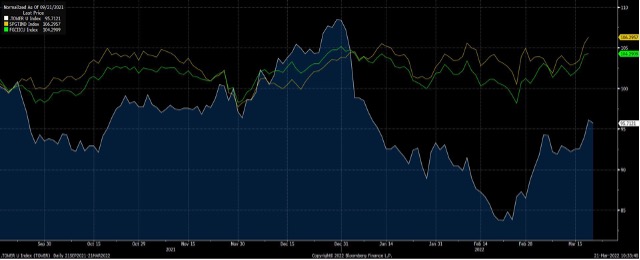Opportunities in equity market volatility
In this wire, 4D senior investment analyst Tasneef Rahman shows how volatile markets often give rise to the best investment opportunities. Investors can overreact to current news/events, resulting in short-term volatility in stocks prices, while ignoring the investment fundamentals and underweighting probabilities on long-term value realisation.
Listed infrastructure is an equity and is not immune to market volatility. From politics, economic data, pandemic related news and now conflict – volatility can skew the risk/reward balance in favour of the fundamentally focused, long-term infrastructure investor. We at 4D look to capitalise on this market characteristic.
Let’s consider the recent underperformance of the communications infrastructure sector. Growing concerns around inflation and consequent rate rises have seen share prices of communication tower companies pull back significantly. The chart below shows the underperformance of the sector vs broader infrastructure indices (1).

Bond proxies and long duration tags
One reason for the recent underperformance can be explained by the market characterisation of communication towers as ‘bond proxies’ and/or ‘long duration’ assets.
Bond proxies are stocks that offer predictable returns, are generally highly leveraged and, like bonds, are perceived to be very price sensitive to interest rate moves. As such they tend to be most prized in a low growth/low interest rate environment.
Often they’re also classified as long duration, meaning a greater proportion of value is dependent on future cash flows. Long duration isn’t limited to real assets, however; it also extends to riskier areas of the market, from infrastructure sub-sectors like renewables to broader areas like technology. Here unprofitable or less profitable companies are also seen as long duration, e.g. unprofitable now, but recognised for future earnings potential.
With their long-term contracts and above average leverage, tower companies are often bucketed as bond proxies and/or long duration, and hence seen as highly sensitive to interest rate movements.
In a reflationary environment with rising yields, market valuations of both bond proxies and long duration stocks can become challenged. The market discounts future earnings at higher rates and gives preference to cyclical, higher growth companies.
And it appears this is playing out. Higher than expected inflation has meant central banks across the globe have become more hawkish, increasing (or intending to increase) official rates – which has hit these so-called bond proxies and long duration names.
Importance of focusing on investment fundamentals
These simplistic market characterisations often ignore the thematics and stock specific fundamentals which continue to make certain names attractive, irrespective of near-term macro trends.
Specifically, within the towers space, we believe this macro related sell-off has given rise to significant opportunities. To begin with, the business models of tower companies are often very attractive, characterised by:
- Long-term customer contracts with explicit inflation protection or fixed price escalators, often with all or nothing renewal clauses (2),
- High switching costs for customers (mobile network operators) to move to other providers, and
- Strong cash flow generation, with high operating leverage and low maintenance capex.
Industry thematics also continue to act as strong tailwinds to the sector, including:
- Continued growth in wireless data demand driving demand for tenancies on towers,
- Densification needs from 5G, which generally uses higher frequencies and requires more tower sites,
- Lateral growth opportunities, including fibre to the tower, active sharing of equipment and rail / road coverage opportunities, and
- Policy support from governments like the EU, which are prioritising digitalisation and overcoming the digital divide (between urban and rural areas) as a key part of pandemic recovery.
Nevertheless, these characteristics do not apply to all companies equally. Irrespective of themes, individual company quality and valuation remain critical – which is why it is always important to be selective.
Cellnex – focus on fundamentals
A good example of the arguments we make above is European tower company Cellnex, the largest holding in our fund.
Cellnex’s share price has been the weakest in the sector, underperforming the Tower Index by ~20% over the past 6 months.(3) Notwithstanding stock specific factors (e.g. regulation and competition), inflation and rate concerns have been a big factor in the share price fall. However, we believe these concerns are misplaced.
Our analysis suggests Cellnex is better protected from inflation and rates vs the majority of its peers in the sector. Currently 65% of its contracts have CPI links (i.e. if inflation goes up so does Cellnex’s revenue) and the remainder have fixed price escalators. Similarly, ~90% of Cellnex’s debt is fixed – which means if rates go up Cellnex is largely immune, whilst real lease costs per tower are falling with an active optimisation program supporting margins. Having stress tested our valuations for various interest rate and inflation scenarios, we continue to see strong fundamental value in the stock and remain comfortable in the structure of the company’s inflation linked cash flows to mitigate adverse interest rate/inflation impacts. The stock also offers an appealing ~6% RLFCF(4) yield, and trades at a significant and unjustified discount to the peer group at ~17x EV/EBTIDA, vs 22x for the peer group.
What makes us even more comfortable with our position in Cellnex is the numerous positive catalysts (including those thematics aforementioned), the most significant of which is M&A opportunities. The company has ~€8bn of firepower remaining in its M&A pipeline (having already executed on ~€10bn out of its broader €18bn portfolio), which it expects to complete by September this year. We recognise there is risk around M&A, especially with increasing competition in the sector, and importantly we don’t value ‘potential growth’ until it is locked in. But given Cellnex’s strong track record in M&A execution, focus on shareholder returns and overall best in class management team, we think it’s more likely than not they’ll be successful. This would provide significant upside to our valuation and provides an even greater degree of comfort around the fundamentals of the stock, despite the market’s current mis-characterisation of Cellnex as just another rate sensitive, long duration or bond proxy stock. We remain a buyer.
Invest across the globe
4D Infrastructure is a Bennelong Funds Management boutique that invests in listed infrastructure companies across all four corners of the globe. For more insights on global infrastructure, visit 4D’s website.
3 topics
1 contributor mentioned

